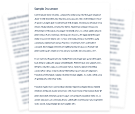Heads of Agreement
A Heads of Agreement is a non-legally binding pre-cursor document that you can use during the negotiation stage to record proposed terms of two parties.
4.3 (118 reviews)
Last updated October 23, 2025
Under 10 minutes
Suitable for Australia
Written by Edwin Montoya Zorrilla
Reviewed by Damin Murdock
Document Overview
When two parties enter into negotiation for an agreement, such as the sale of a business, the parties should seek to formalise the terms of the discussion prior to signing a legally binding document. This gives the parties a chance to process what fulfilling the terms of the contract will mean, and clarify anything before it is too late to make changes. If you are interested in signing an agreement with another party, it is important to record the terms that have been agreed upon in order to protect your business assets and resolve future disputes. It works as an 'agreement to agree', however is not a legally binding contract. If the proposed agreement has a signed paper record, you are able to ensure that the execution of a legally enforceable document is smooth and minimises any potential conflict.
The Legal Risk Score of a Heads of Agreement Template
Our legal team have marked this document as low risk considering:
- The document outlines terms that are not intended to be legally binding except where explicitly stated, which means that commitments made under this agreement may not be enforceable until a final agreement is signed.
- Each party must bear their own costs related to the negotiation and preparation of the agreement, regardless of whether it ultimately proceeds, which could lead to significant expenditures without any guarantee of a return or successful agreement.
- The document specifies that damages might not be an adequate remedy for breaches, suggesting reliance on equitable remedies like injunctions or specific performance, which can be more complex and costly to enforce than simple monetary damages.

Heads of Agreement Checklist
Complete your free Heads of Agreement with our checklist
Finalize the Proposed Agreement:
Ensure that negotiations continue in good faith towards signing the final written Proposed Agreement by the agreed deadline.
Handle Termination Cautiously:
If choosing to terminate negotiations, provide written notice to the other party as specified, and ensure compliance with any obligations such as returning materials or information.
Review Existing Agreements:
Confirm that any existing agreements that might affect this heads of agreement are reviewed and remain in full force as stated.
Seek Legal Review:
Have the document reviewed by a lawyer on the Lawpath platform to ensure all legal bases are covered and the document meets all necessary legal standards.
Use this Heads of Agreement if:
- You would like to set out the proposed terms of an agreement between you and another party during the negotiation stage before a formal agreement is made.
- You would like to set out in writing the intention of the parties moving forward.
What does the Heads of Agreement cover?
- Details of the proposed formal agreement;
- Obligations of both parties;
- Consideration for the proposed agreement; and
- Options to include clauses for confidentiality, intellectual property, non-solicitation and/or exclusivity obligations.
Other names for Heads of Agreement include:
- Gentlemen's agreement; and
- Commercial Lease Heads of Agreement.
Further agreement
What is the difference between a Heads of Agreement and a Memorandum of Understanding?
A Heads of Agreement (HoA), properly drafted, is a non-binding document which sets out the key terms of a proposed agreement between parties. The general intention of a Heads of Agreement is that the document is not legally binding, but in some circumstances it can become legally binding. A memorandum of understanding (MoU) is generally used to document a relationship of goodwill between the parties. A memorandum of understanding is generally not legally binding, unless the agreement satisfies the the elements of a contract.
The difference between the two is that you enter a HoA when you want to document a summary of the key provisions that you and the other party intend to later include in a legally enforceable contract, whereas a MoU, you are not making promises that you or the other party want to be able to legally enforce in a court or through some other legal process.
Is it necessary to use a Heads of Agreement?
While not enforcing both parties to reach an agreement, the document is a gesture of good faith by evidencing both parties commitment to proceed with a binding agreement. The Heads of Agreement ensures that both parties can continue negotiating the final terms of the agreement, make the relevant enquiries before reaching a conclusive decision and exclude third parties from entering into negotiations.
Other key reasons why parties should use a Head of Agreement include:
- It’s a mechanism for resolving disputes to clarify to both parties what the end Agreement will include
- Protects business assets, information and employees from the negotiating party
- Outlines the parties key roles and responsibilities
- Formalises and streamlines the negotiation process
Are the terms of a Heads of Agreement legally binding?
The terms of an HoA are generally not legally binding, however, they have the potential to become a legally binding document. If the HoA satisfies the criteria of a contract, then it does become a legally binding document. If all of the elements required to make a contract are satisfied, a contract will be formed. With this in mind, if the promises made in the HoA are not met, the other party can legally enforce the document in order to make sure the terms are met.
How do I terminate this agreement?
The best way to terminate an HoA is by including a termination clause into the agreement. This will allow you to be able to part ways with the agreement once a certain criteria is not met or satisfied. An example of this is a termination date. A termination date is the ability to terminate an agreement on a certain date if/ when agreed upon terms are not met. Once the HoA does not satisfy its elements by a certain date the agreement can be terminated.
View Sample Heads of Agreement
It's never been so easy
Sign-up to a free Lawpath account
Get started and we'll take care of you. It's that easy.
Browse our 500+ legal documents
Browse our 500+ legal documents to find the perfect match to cover your business needs. We've got Compliance, Employment, Service agreements and more.
Collaborate with e-Sign and Sharing
Having access to your legal documents has never been easier. You can request e-signature, share the document and download for an efficient collaboration.
Create unlimited legal documents and eSignatures for only $39/month.
Upgrade to a Lawpath legal plan to boost your new business.


Here's what people say about Lawpath's Heads of Agreement
Reviews are managed by BazaarVoice and comply with the BazaarVoice Authenticity Policy. Reviews are independently verified by BazaarVoice and detail our customers' real experiences.
0 reviews
Most Recent
Highest to Lowest Rating
Lowest to Highest Rating

